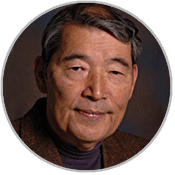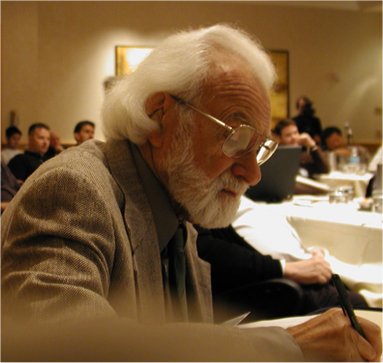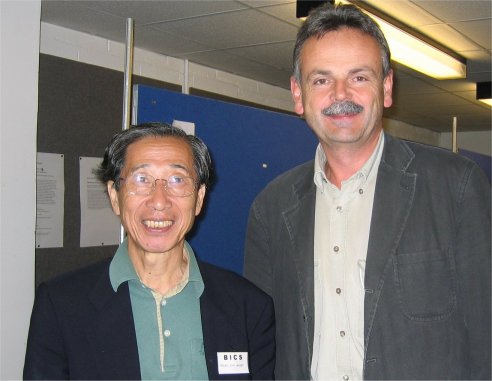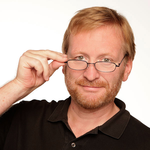



First of all, we can remember Karl S. Lashley (L) (June 7, 1890 - Aug.7, 1958) and Lloyd A. Jeffress (R) (Nov.15, 1900 - April 2, 1986). Independent of each other they had found first indications for elementary interferencial principles in the early 1940th. Karl Lashley had proposed 1942, that interference patterns among wave fronts in brain electrical activity could serve as the substrate of perception and memory as well. After 30 years of rat-experiments he predicted a "holographic" memory. Lloyd Jeffres gave 1947 a first interference model for sound localisation of barn-owl, the first interference model ever.

Andrew Packard (March 8, 1929 Sedbergh, UK - June 15, 2023 La Garde-Freinet, France) gave the proof for the wave nature of nerve pulses. He was the man, who made 1995 one of the most important and direction-giving discoveries in Neuro-Science. He found
"A neural net that can be seen with the naked eye" - excitation waves - characteristic pulse waves - on the skin of squids (octopus). Chromatophores expand and contract, showing the stimulating pulse waves in the nerve net behind.
In 1957-1958 he discovered living organisms in the antarctic ice. The
Packard Glacier in Antarctica is named for him.
We meet us at a conference at the isle of
Ischia 1998 and became friends.

While I wrote 1993 the book "Neuronale Interferenzen", Mazakazu (Mark) Konishi (17 Feb.1933 - 23 July 2020) brought an interference network for sound localization to widest audience. The circuit was a simplified version basing on the findings of his teacher Lloyd A. Jeffress. We had interesting discussions. Read an introduction about his and Lloyds findings here.

Interference nets do not need any artifical background to be holistic. As a student and co-worker for the rat experiments of Karl Spencer Lashley, Karl Pribram (Feb.25, 1919 - Jan. 19, 2015) had special interest in the new field of holography, invented by the Nobel Price winner of 1971 Dénes Gábor. Pribram brought the idea of holonomy into neuroscience in the 1960s (applying holography onto inhomogeneous substrates (nerve nets). Independent of him, I called the holistic approach in the 90th the "Interference Networks". See a preview of some details in "Brain and Mathematics". It is impressing, which genious imagination Karl Lashley had in the late 1940th about nerves, interference pattern and holograms. Donald Hebb played an important rule in his findings. Find the amazing story here.

Inspired by Karl Pribram's holonomy Walter Freeman (Jan. 30, 1927 - April 24, 2016) 1972 had the inspiration to draw a neural field with probability waves*. We used the chance to talk about discrete, non-linear wave fields and holonomy in Wildbad Kreuth/Bavaria 2007
* Freeman, Walter J.: Waves, Pulses, and the Theory of Neural Masses. Journal PROGRESS IN THEORETICAL BIOLOGY, VOL. 2, 1972, Academic Press Inc.

Mosche Abeles was so kind to talk with me about his synfire chains as archetypes of interference nets in Rehovot/Israel 2005. Invited by Prof. Benny Hochner (Hebrew University of Jerusalem - HUJI) I had the chance, to meet scientists and to hold lectures about Interference Networks.

Shun-Ichi Amari in Berlin 2000 and in Stirling/Scotland 2004 was open to discussions of interferencial predictions for his cognitive networks - a possibility to reach advance in the recognition of the function of nerve nets.

A pioneer of acoustic mapping, John Billingsley, was one of the first, who used microphone arrays. He told about his 'Acoustic Telescope' a nice story.

Hans-Heinrich Bothe (25 Sept.1956 - 30 July 2013) was the person, who encouraged me to proceed with research and publications about interference networks without of any grants. Together with Jenny Ryffel he organized the last large neuro-conferences. I held lectures at his conferences in Cuba 2002, Australia 2000 and Berlin 2000. Hiking in the Südtiroler Alpen, Hans died much to early. We will never forget him.

The first demonstration for the specific behaviour of interference networks were acoustic images. And she was the person, who developed the software for first interference network simulations and for the worlds first acoustic images and movies. Together we tried to understand what we are doing. "Biene" Sabine Höfs (geb. Schwanitz) worked from 1993 to 1997 at GFaI. Now she is a successful businesswoman. Find details about her software PSI-Tools here. The later
medial interest
in these findings was surprising.
I think, today several hundred persons found acoustic imaging jobs for their living in dozens of companies worlwide: they all should be grateful to her, she opened the door of acoustic photo- and cinematography.

Visitors since Dec. 2021: